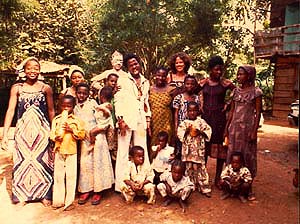Christine Kristen (aka LadyBee) was Burning Man’s art curator from 1999-2008. She wrote this essay in 2002. It grew out of the introduction to a slide presentation on the art of Burning Man given at White Columns Gallery, New York, on April 26, 2002.

A view to the Man from above the cafe, including (clockwise from left) theme art installations the Plastic Chapel, the Hearth, the Luminator, the Coliseum,the Chamber of Creation, and the Bike Carouse
As a child I loved to paint and draw and by the time I finished high school I had decided to devote myself to the making of art. I went to art school in the seventies and completed an MFA in sculpture from the School of the Art Institute of Chicago, fully intending to pursue a gallery career, but I got sidetracked by my curiosity about African culture, which had evolved during several years of studying West African dance. Intent on living in Africa, I joined the Peace Corps and spent the next four years in Africa and the West Indies. There I had two experiences which probably were the beginning of my fall from the art world, although I didn’t know it at the time. While I was teaching art in a rural secondary school in Lesotho, Southern Africa, I noticed that sometimes one student would begin a drawing and would then pass it on to another, who would finish it. This fascinated me and went against everything I’d been taught in art school, where the cult of the individual was powerful and one wouldn’t dream of making a mark on another’s work. These students didn’t think twice about sharing their images, nor did they seem particularly attached to them after they were finished, often leaving their work behind without a care. It seemed that the only thing that really meant something to them was the experience of creating the work.

In West Africa I encountered a culture where artists were welcomed into the general community and worked side by side with everyone else; they created work that was used, sometimes ritually, by the community, and which was held in very high esteem. The community was intimate with the objects they made, and everyone seemed to feel connected to them and to genuinely care about them. This of course was quite different from the world I came from where most people had little or no interest in art objects, and where the artists felt disconnected from the rest of the culture. In addition, almost everyone here made some kind of decorative art object which was used every day, and there really didn’t seem to be much separation between art and life. Of course the purpose of this art was different than Western art, which is based on self-expression and the individual and not intended for any sort of practical use; nevertheless a kind of wholeness seemed to exist here, which was very attractive to me after experiencing the fragmented life of an artist struggling to survive in a culture which didn’t seem to place much value on art. However, I didn’t quite know how to work and survive outside the world in which I was trained and I returned to Chicago and continued making my work. I started exhibiting and selling my work, and after a few years I decided to move to New York, the great proving ground for artists. In 1984 I took up residence in Williamsburg, Brooklyn, where I spent the rest of the eighties.
In Chicago, I was surrounded by an intimate community of peers, but when I moved to New York I became one of thousands of painters and sculptors all struggling to get their work seen in an intensely competitive environment. I spent a lot of time, like everyone else, going to openings, dropping slides off at galleries, and trying to meet critics, dealers and curators. It occurred to me that all of us were engaged in this rather soulless pursuit that reflected only itself and had very little to do with anyone outside our immediate circle. It seemed as if the artists were making art for the other players in the art world, who had inside information on the nature of that work. For the general public, who didn’t have this special information, the work was confusing and out of reach.

